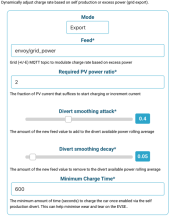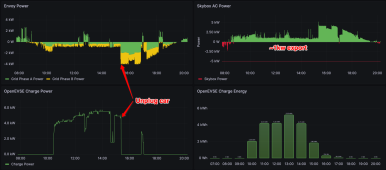Given the setup you have, there's no easy way to do what you want. (You don't feed energy to the grid.)
That's not to say it's impossible, but it's much harder. You need some cooperation from the battery and some hardware hacking.
I'd have to actually see one of the sensors to be sure, but there's a high probability that those sensors are nothing more than loops of wire around a magnetic core, or an extended coil around air, and have no active electronics in them at all.
In which case, a knowledgeable person could easily design a small gadget that could inject an arbitrary signal into one of the ports. You would basically hook up a transformer with an inductance on one coil that matches the inductance of the sensor, and on the other coil you would inject a current with a current amplifier that is equal to the mains voltage times a control variable. If the control variable is positive, the system will interpret that as consuming power, and if the control variable is negative, the system will see that as releasing power, with the absolute value of the control variable telling the system how much power is being moved. Then you need do nothing more than set this control variable according to what is happening to the battery.
That's not too hard: if the battery is fully charged, you trick the system into thinking power is going out to the grid by slowly increasing the "outgoing" power --- but the moment the battery starts to discharge, you decrease the "outgoing" power until the battery starts to charge again (or at least stops discharging), plus a little more. You then wait 30 seconds, monitoring to make sure the battery doesn't start discharging, and then repeat the process of ramping up the current again. It's not a perfect solution, but it will get you close to consuming as much power as possible.
It's the kind of thing a good hardware hacker could slap together in a day if they already had the parts on hand.






